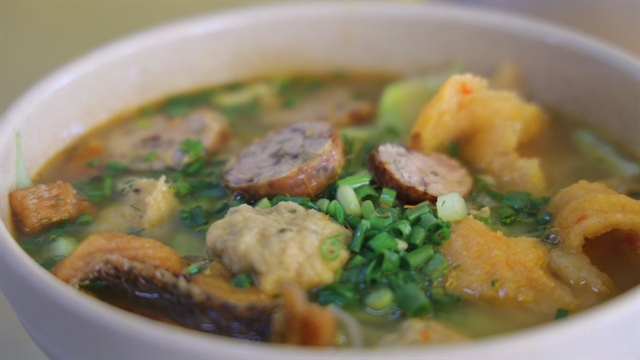 Life & Style
Life & Style

Jacques de Guerny, a French researcher has spent more than three years tracing the evolution of bronze drums in Southeast Asia, including in Việt Nam.
 |
| Jacques de Guerny is presenting his book “Bronze Drums of Southeast Asia” in Hà Nội on November 5. — VNS Photo Mai Phương |
Mai Phương
HÀ NỘI — Jacques de Guerny, a French researcher has spent more than three years tracing the evolution of bronze drums in Southeast Asia, including in Việt Nam.
With his insatiable passion for drums, Jacques, who is an expert on economics, a professor and lecturer from the HEC University in Paris and Harvard Business School in the US, has poured much of his resources and time into researching these drums, some of which date back 2,500 years.
He has travelled across Việt Nam, Cambodia, Laos, Myanmar, Thailand, Indonesia, Malaysia and China to get materials for research and to find communities that use drums not only as a source of sound but to evoke values deemed crucial for everyday life or for the afterlife.
“A lot of bronze drums had been made and described by local or foreign scholars and missionaries but their mystery endured as far as different hypotheses were put forward, often antagonist, to explain the origin and development of these nice masterpieces which metal is not yet possible to date,” de Guerny wrote in his book, Bronze Drums of Southeast Asia.
The book written based on his travel experiences and passion for bronze drums, was introduced at a seminar held in Hà Nội early this month.
 |
| Ngọc Lũ bronze drum, one of the most important and prominent artifacts of the Đông Sơn culture of the Bronze Age, is displayed at the National Museum of History in Hà Nội . — VNA/VNS Photo Đoàn Tùng |
In the book, de Guerny shared his research on the history of bronze drums saying that “a bronze drum’s first amusing way of approach maybe to remember how our predecessors reacted punctually in both eastern and western worlds, first speaking of ‘kettledrums’ like pots with their thin walled bodies, or ‘metal drums’, or ‘kettle gongs’, not forgetting many other local callings.”
The French researcher spent nearly 30 pages of his 190-page book revealing the history of bronze drums found in Việt Nam, including those of the Đông Sơn, Cẩm Giang and Lang Chánh drums in the central province of Thanh Hóa, Ngọc Lũ bronze drum in the northern province of Hà Nam, Moulié Drum or Sông Đà Drum found in the northern province of Hòa Bình, Hoàng Hạ drum found in Hà Sơn Bình Province (now Hà Nội) and many others.
De Guerny visited museums in Việt Nam that display bronze drums and talked to museum directors and historical researchers across the country, including those in Hà Nội, Thanh Hóa Province and HCM City.
The Frenchman said his trips to Việt Nam gave him opportunities to meet people who supported him greatly in his work.
“I have met with very interesting and kind people pảticularly those from the National Museum of History in Hà Nội and the Regional Museum in Thanh Hóa, who are very supportive and understand what I am doing. I find no difficulties when doing my research in Việt Nam.”
“I decided to investigate the ‘bronze drum case’ not only to consider the existing studies but to visit all specific areas involved, with the help of the best scholars and local people,” said de Guerny.
“My purpose was not to write a new thesis but to relate, as objectively as possible with simple words, to give to the readers and maybe visitors some keys to understand and hopefully join me to become a bronze drums lover,” he added.
 |
| The cover of the book "Bronze Drums of Southeast Asia". — VNS Photo Mai Phương |
Professor Trịnh Sinh, an expert on archeology, history, culture and art from the Graduate Academy of Social Science, appreciated de Guerny and his research about bronze drums.
Sinh, with whom de Guerny met to ask for help for his book, highlighted the French researcher’s choice to approach ancient drums and history by travelling to areas where the bronze drums were found.
The expert said the book should be published in different languages, including Vietnamese, as it would likely make a contribution to historical research.
In his research, de Guerny said bronze appeared to be an outstanding material for drums, adding more sonority to their wooden predecessors and receiving all types of decoration.
The bronze drums story, covering more than two and a half millennia, was undoubtedly part of human heritage, according to de Guerny.
After so many trips to Việt Nam and other countries in Southeast Asia, de Guerny said it was a must to summarise the main clusters of bronze drums, a musical instrument composed of a tympanum at the top of an open cylinder.
“Around 500 BCE, bronze drums were invented in independent kingdom(s) around the Red River Basin irrigating future Yunnan (China) and future Tonkin (Giao Chỉ -Việt Nam). Dian lake culture in the North of Việt Nam and Đông Sơn on the Mã River in the country’s South were the main geographical landmarks for a family of ceremonial bronze products of which drums took the most revered place during at least six centuries,” de Guerny wrote.
De Guerny said he was aware that he is at a disadvantage to other professional archaeologists, cultural experts and historians who entered the field at a much younger age.
However, he still manages to astound his peers with his deep understanding of the role of the bronze drum in the lives of various cultures throughout Việt Nam and Southeast Asia.
“Be that as it may, drums were part of the final sophistication of the Bronze Age in Asia, avatar of one of the oldest musical instruments ever created and popular until now in human lives and beliefs,” said de Guerny.
Jacques de Guerny’s book, Bronze Drums of Southeast Asia, was published in 2017. The basic paper and e-book editions are sold in French: Les tambours de bronze de l’Asie du Sud-Est - ed Hemispheres -Paris 2017. — VNS




